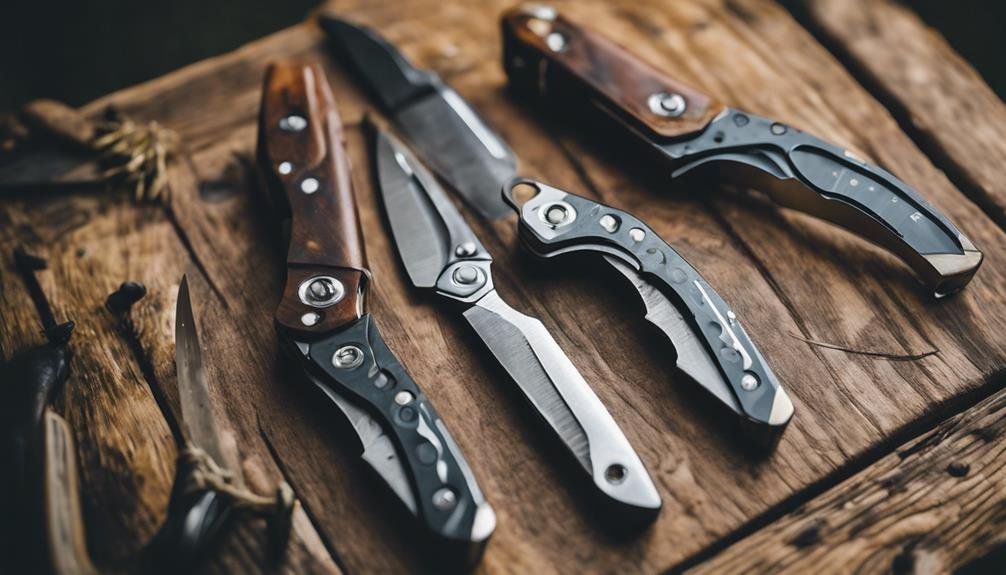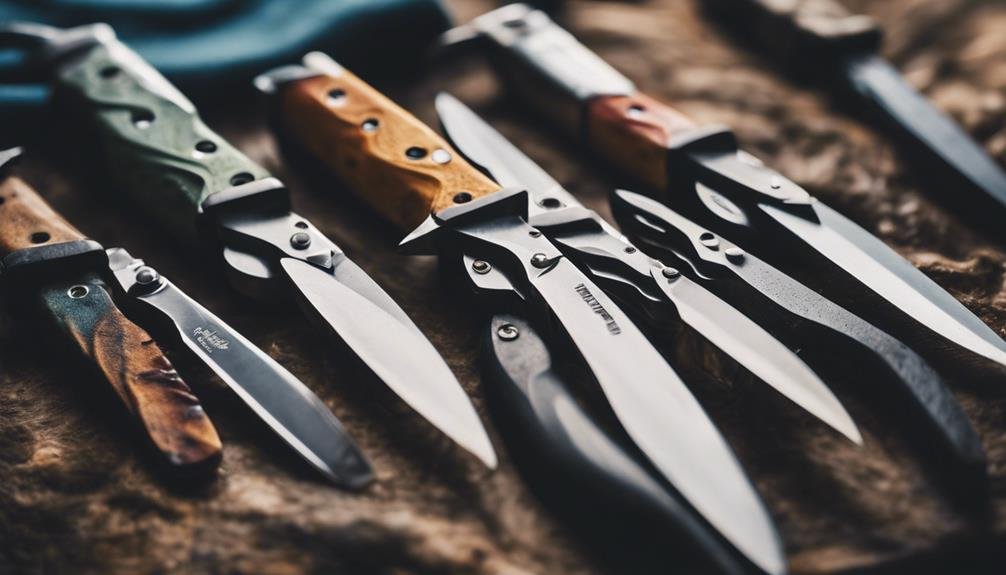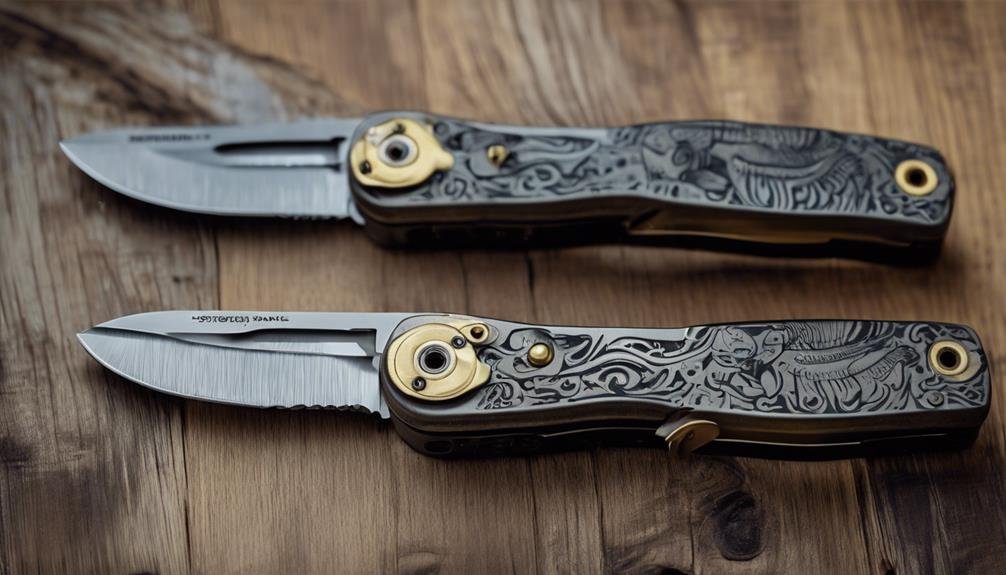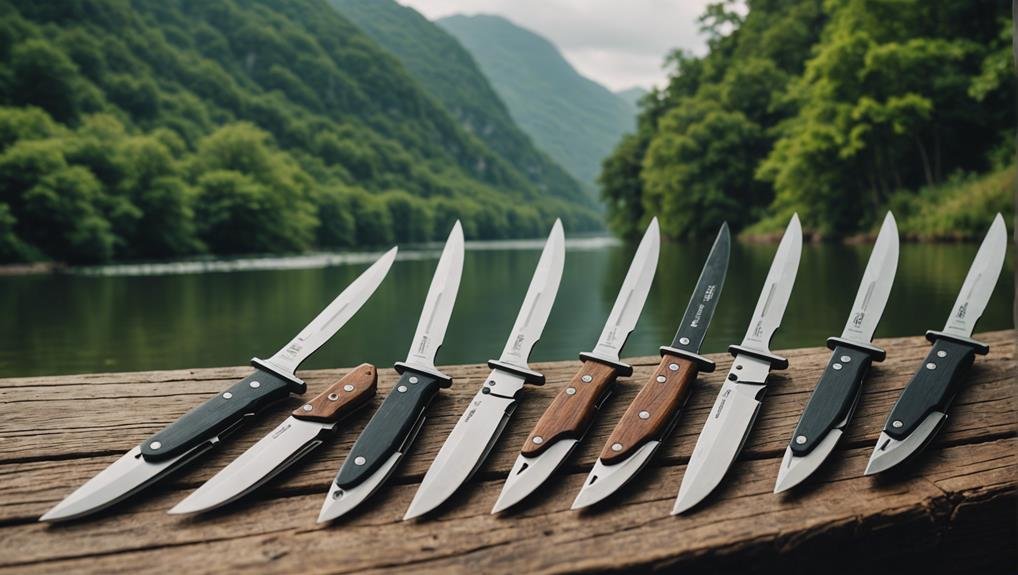The right folding fishing knife can make all the difference when you’re on the water. You’re likely looking for something sharp and sturdy that fits comfortably in your hand. However, with so many options on the market, like the AquaBlade Pro and RiverRun Elite, how do you know which one will best meet your needs? Consider what matters most to you: is it the blade’s durability, the handle’s grip, or perhaps the safety features? Let’s explore what sets these top contenders apart and determine which might be the right companion for your next fishing trip.
Key Takeaways
- Review top folding fishing knives like AquaBlade Pro and RiverRun Elite for blade sharpness and quality.
- Consider size and ergonomics to ensure the knife fits well in hand and enhances fishing efficiency.
- Check for corrosion resistance and blade thickness to gauge durability in wet conditions.
- Evaluate safety mechanisms such as Liner Lock and Frame Lock for secure handling.
- Regular maintenance, including cleaning and oiling, is essential for preserving knife performance and longevity.
Key Features to Consider

When selecting a folding fishing knife, it’s crucial to consider blade sharpness, durability, and grip comfort. A sharp blade guarantees you can easily cut through bait, line, and potential catches. You don’t want to be stuck on your boat, yanking on a dull blade, right? Look for knives that boast high-quality steel, often promising that sharp edge you’re after.
Now, let’s talk about size variability. You’ll find folding fishing knives ranging from compact models that fit snugly in your pocket to larger ones that demand more space in your tackle box. Consider how you plan to use your knife. A larger knife might be perfect if you’re often out in the open water and space isn’t an issue. But a smaller one could be better if you hop around streams and prefer minimal gear.
Always consider how the knife’s size impacts its overall utility. A too-small knife might be tricky to handle when cutting thicker lines or tougher scales, while a too-large knife can be cumbersome and unsafe if you’re wading or in tight spaces. Finding that sweet spot in size can significantly enhance your fishing experience.
Top 5 Folding Fishing Knives
Now that you know what to look for, let’s explore the top 5 folding fishing knives on the market. Each knife has been selected for its exceptional blade sharpness and striking design aesthetics, ensuring they’re practical and visually appealing.
First up is the AquaBlade Pro. Known for its ultra-sharp blade, which easily slices through the toughest fish, its sleek, blue-toned handle is as eye-catching as it is functional.
Next, you’ve got the RiverRun Elite. This knife features a serrated edge perfect for cutting through ropes and nets, complemented by a classic wooden handle that stands out for its elegance.
The third spot goes to the SeaSharp Navigator. It boasts a corrosion-resistant blade that maintains its sharpness even after repeated exposure to saltwater. Its compact design makes it easy to slip into your pocket without sacrificing style.
Fourth on the list is the Angler’s Choice Spectra. This knife’s blade is designed for precision filleting, and its vibrant rubber grip handle makes it a favorite among modern anglers.
Rounding out the top five is the TideMaster X. It combines a high-performance blade with a futuristic handle design, making it a top choice for tech-savvy fishermen looking for efficiency and flair.
Handling and Ergonomics

Handling your folding fishing knife comfortably can greatly enhance your fishing experience. The ergonomics, including grip texture and balance precision, play pivotal roles in effectively using your knife.
Let’s dive deeper into these aspects.
First, consider the grip texture. It’s important because you’ll often handle your knife in wet conditions. A knife with a slip-resistant texture will guarantee that it stays securely in your hand, even when slick with water or fish slime. You don’t want to fumble with your knife when cleaning or cutting bait quickly.
Next, let’s talk about balance precision. A well-balanced knife feels like an extension of your hand, making it easier and more comfortable for extended periods. It reduces fatigue in your wrist and arm, which is essential during long fishing trips. When the weight distribution from the handle to the blade is just right, you’ll find that cutting and slicing feel more natural and require less effort.
Durability and Material Quality
After considering the ergonomic features of your folding fishing knife, it’s equally important to examine the durability and quality of the materials used. When you’re out on the water, the last thing you want is a knife that deteriorates quickly. That’s why corrosion resistance is a key characteristic to look for in the blade. Most high-quality folding fishing knives are crafted from stainless steel or other alloys to resist rust and corrosion in wet environments.
You’ll also want to pay attention to blade thickness, which is vital to the knife’s overall sturdiness and ability to handle various tasks. A thicker blade means it’s less likely to bend or break when cutting through tough bait or fish. However, a balance is necessary because a too thick blade can make the knife cumbersome and difficult to handle precisely.
Choose a knife that feels solid and shows no signs of flimsy construction. Check the joints and the pivot point where the blade folds into the handle; these should be robust and wobble-free. A well-built folding fishing knife lasts longer and ensures a safer and more effective cutting experience every time you use it.
Safety Mechanisms Explained

When selecting a folding fishing knife, it’s important to consider the safety mechanisms that prevent accidental closure during use. These features are vital for your safety, ensuring the blade remains securely open while cutting bait or filleting your catch. Understanding different locking types and release systems can help you choose a knife that matches your fishing needs and personal preferences. Here’s a closer look at these mechanisms:
- Liner Lock: Once the knife is fully opened, a thin metal liner inside the handle moves behind the blade, locking it into position. You’ll need to move the liner aside to close the knife manually.
- Frame Lock: This is similar to the liner lock but uses a thicker piece of metal as part of the handle frame to lock.
- Lock Back: The knife features a locking bar running along the handle’s spine that flips up to catch on the blade’s notch, securing it. To fold the knife, you press down on the release at the back of the handle.
- Button Lock: Engages a small button on the handle to release the blade from its locked position.
- Slip Joint: This is not a true locking mechanism but provides resistance that prevents the blade from closing inadvertently.
These mechanisms enhance your safety by ensuring the blade doesn’t accidentally fold back on your fingers during use.
Maintenance and Care Tips
To guarantee your folding fishing knife remains in top condition, regularly clean and oil the blade and moving parts. Rinse the knife with fresh water after each use, especially in salty environments. Dry it thoroughly to prevent rust. Apply a mild detergent with a soft brush to the blade to tackle any stubborn residue. Avoid harsh chemicals that can damage the knife’s material.
Once cleaned, apply a light oil to the blade and pivot points; this keeps the action smooth and wards off corrosion. Ensure you’re using an oil appropriate for fishing knives, ideally one that doesn’t attract dirt or emit strong odors that could affect your catch.
For storage solutions, don’t just toss your knife into your tackle box, where it can get banged up. Instead, invest in a knife sheath or a dedicated compartment. This protects the blade and keeps it sharp. Additionally, store your knife in a dry place to avoid moisture buildup, which can lead to rust. With these cleaning techniques and storage solutions, you’ll extend the life of your folding fishing knife and keep it ready for your next fishing adventure.
Conclusion
In choosing your folding fishing knife, focus on blade sharpness, durability, and handle ergonomics for the best experience.
Whether you opt for the AquaBlade Pro or the TideMaster X, ensure it fits your needs.
Don’t overlook the importance of safety mechanisms and regular maintenance to keep your knife in shape.
With the right folding fishing knife, you’ll enhance your fishing adventures, making every catch smoother and every cut precise.

